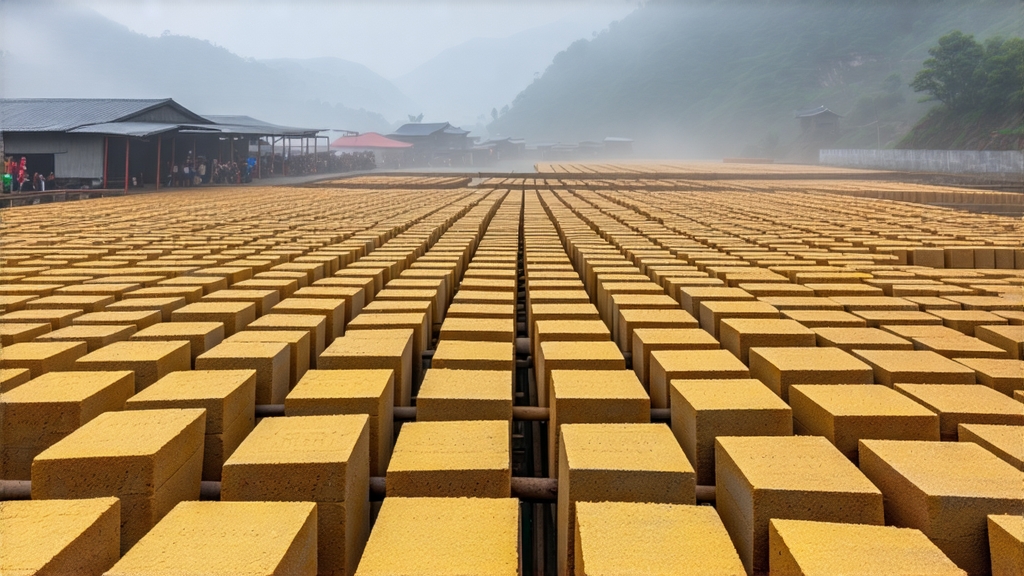
Tucked away in the humid mountains of Hunan Province, a dark, brick-shaped tea has been quietly fermenting for more than six centuries. To most Western palates the word “black tea” conjures images of brisk Ceylon or malty Assam, yet in China the true “black” teas—heicha—are post-fermented, microbially alive, and capable of improving for decades. Among them, none carries the romance, science, and flavor alchemy of Fu brick tea, or Fuzhuan cha. Once compressed to ease the trek of camel caravans bound for Central Asia, Fu brick is now prized by collectors who cellar it like vintage Bordeaux. This article invites you to meet the tea that literally grows “golden flowers” before your eyes.
-
From Frontier Currency to Modern Super-food
During the Ming Dynasty (1368-1644), the imperial court exchanged tea for Mongolian war-horses along the northwestern frontier. Pressing low-grade green tea into bricks reduced volume and deterred moisture, but the long, steamy journey accidentally triggered a second fermentation. By the time the cargo reached the markets of Kashgar, the tea had darkened, mellowed, and developed a beguiling hay-sweet aroma. Tibetan and Kazakh herders found that a small piece dissolved in yak butter aided digestion of rich, mutton-based diets and offset vitamin deficiencies at high altitude. The court quickly designated “Official Tea Roads,” and the town of Jingyang in Hunan became the authorized production center. Thus Fu brick was born—not as a connoisseur’s luxury, but as strategic calories for empires. -
The Microbe That Sells for More Than Gold
What separates Fu brick from other compressed teas is the compulsory bloom of Eurotium cristatum, a harmless mold that appears as tiny yellow-gold dots called “golden flowers” (jin hua). Far from being spoilage, these flowers are a quality marker; bricks achieving > 20 000 colonies per gram fetch triple the price. Chinese scientists have identified polysaccharide complexes unique to E. cristatum that inhibit α-glucosidase, suggesting potential anti-diabetic properties. Meanwhile, gas-chromatography reveals a ten-fold increase in 2,4-dimethylfuran, the same compound that gives toasted bread its comforting note. In short, the microbe rewrites the chemistry of tea, converting harsh catechins into mellow theaflavins and releasing a lingering honey sweetness impossible in younger teas. -
Crafting a Living Brick
Fu brick production follows a rigid calendar. After the spring harvest, large-leaf tea from the Qianliang mountains is withered, pan-fired, and rolled much like green tea. The crude maocha is then piled 70 cm deep in humid rooms where it undergoes 18–24 hours of “wet piling” (wo dui), a light version of the microbial sauna used for Shu Pu-erh. Once the inner temperature hits 58 °C, workers turn the pile, allowing oxygen to fuel desired microbes and suppress pathogens. Next comes the critical “flowering” stage: tea is steamed at 102 °C for 8 seconds to re-hydrate, then pressed into 2 kg bricks under 50 tons of pressure. Bricks are stacked inside pine-wood kilns maintained at 28 °C and 75 % RH for 12–15 days. A tiny vent in each brick allows just enough oxygen for E. cristatum to germinate, while the outer surfaces are kept sterile by a tight wrap of woven bamboo. When the golden flowers reach peak density, the bricks are moved to shaded mountain caves where they age for a minimum of one year before release. -
Telling Fu from Fake
A genuine Fu brick feels porous yet rigid; tapping it produces a hollow drum-like sound. The surface should show an even dusting of gold, never green or white fuzz. When broken, the cross-section displays a “starry sky” pattern—tiny yellow spots no larger than sesame seeds. Counterfeit bricks often inject corn starch to encourage fake flowering, but the scent betrays them: instead of dry hay, apricot, and camphor, they smell of damp cardboard. Finally, authentic bricks bear a paper ticket stamped with the lot number and the Daoist “Fu” talisman, a heritage logo protected under China’s GI system since 2008. -
Brewing: From Tibetan Stew to Gaiwan Elegance
Traditional border preparation calls for boiling: a 10 g chunk is simmered for ten minutes with yak butter, salt, and occasionally